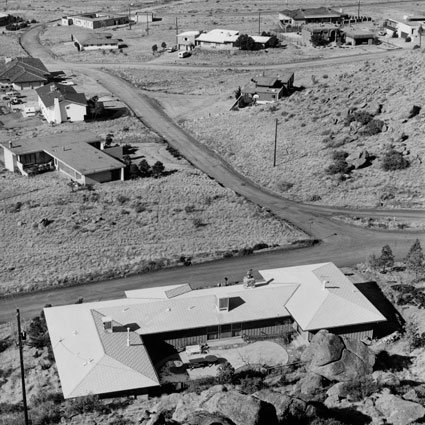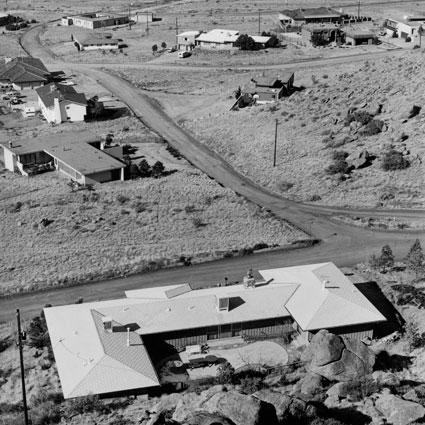"One of photography’s greatest values is in how it allows you to see through the eyes of a contemporary a situation which has now passed. I definitely feel that the value of the photographs in this show will be more recognizable in time than they are right now to a majority of people."
—Joe Deal, speaking at Arizona State University in 1977 about New Topographics: Photographs of a Man-Altered Landscape.
Visitors to LACMA’s presentation of New Topographics: Photographs of a Man-Altered Landscape, which opened yesterday, have the opportunity to hear the artists talk about photography, their influences, and experiences. Just be sure to bring your cell phone; using your phone, you’ll be able to listen to an audio tour with clips spanning the decades since the show was first seen in 1975 at the George Eastman House in Rochester, New York.

Joe Deal, Untitled View (Albuquerque), 1974, printed 1975, gelatin silver print, George Eastman House collections, © Joe Deal
Coming up with audio from each of the ten photographers in the original show was no small feat. The clips were culled from roughly eight hours of audio, collected after contacting nearly fifty different archives in universities, libraries, and museums across the country. The earliest recording is from 1977—Joe Deal (excerpted above)—and the most recent was recorded this past summer expressly for LACMA—John Schott, reminiscing about photographing motels along Route 66. All of it was entertaining; I’m always fascinated at how vocal inflections from another era sound so, well… of another era (I must say, all the female audience members asking questions of Joe Deal in 1977 sounded like Jane Fonda in The China Syndrome to me).
Hearing the voices of the artists makes me feel that much closer to the work on the walls. I heard their distinct personalities, and I came to some quick conclusions that fuel my reception for their imagery: Robert Adams is a philosopher; Lewis Baltz, an anthropologist; Hilla Becher found art to be a visual dance; Joe Deal was quite prescient; Frank Gohlke is a storyteller; Nicholas Nixon is pragmatic, yet deep into image-making; Stephen Shore found art in keeping a visual diary of his life; John Schott was finding a new vision; and Henry Wessel explained to me what it means to follow visual instinct.
We are entering a time when knowing our heroes intimately through Twitter and the like is not unusual. But keeping and making accessible oral and video archives of what an artist was thinking years and decades ago is priceless.
Sarah Bay Williams, Ralph M. Parsons Fellow, Wallis Annenberg Photography Department



